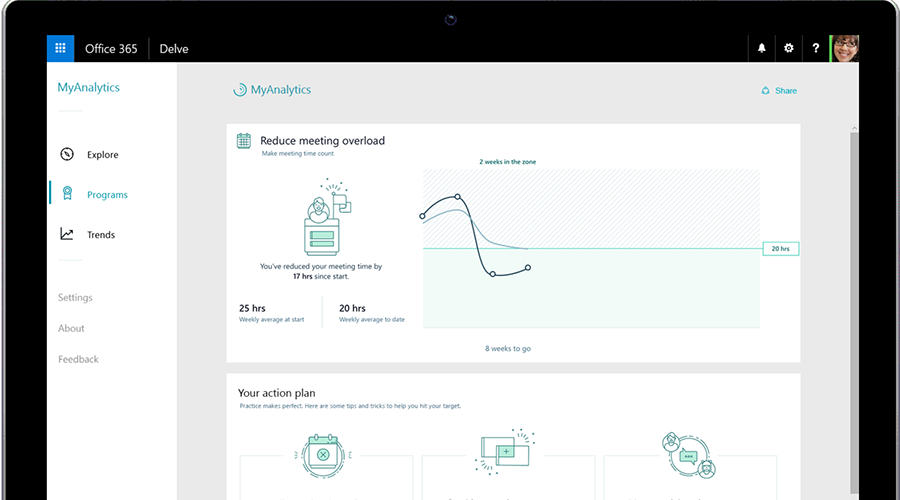5 Tips for a Blissfully Easy Office 365 Roll Out
If you're reading this, you're probably involved or soon to be involved in rolling out Office 365 to your organisation. Whether you are setting Office 365 up yourself or liaising between your users and your IT consultants we have a few tips to make the process go as smoothly as possible.
Hi, we are Happy
We are leading a movement to create happy, empowered and productive workplaces.
How can we help you and your people to find joy in at least 80% of your work?

Why move to Office 365?
This should be the starting point of your Office 365 journey. If you work in a large organisation this may already be mapped out as part of a digital transformation programme.
The simplest scenario is often that Office 365 has come along just to give you access to the latest desktop applications and email. There may be no need for Teams, OneDrive or SharePoint at all. But beware, someone, somewhere down the line will think that all these exciting features are a wonderful idea!
It may be that you need a simple Cloud-based file store to replace an ailing file server with the added benefit of remote access and email. If no other processes in your organisation are changing significantly then the creation of sites and libraries could be very simple. Making your new libraries echo your existing file structure may help users adapt to SharePoint.
The full digital transformation is becoming more common. This involves making full use of Office 365's feature to revolutionise your business process allowing seamless remote and mobile working.
Here are our top five tips for a blissfully easy and stress-free Office 365 roll out.
1. It's good to talk!
You need your users to buy into this Office 365 project. You may face resistance caused by fear, anger, stress, workload, any number of reasons. The most powerful weapon you have is involvement.
Start talking to the end users at the earliest opportunity. Remember, many will have fallen victim to previous software roll outs. Making them the centre of the process will develop ownership.
Explain the reasons for the changes, promote the benefits to them and be honest about the challenges. Within organisational and technical limits, allow the teams as much freedom to design their own solutions as possible.
Find out how the end users use the current software, what works for them and what does not. Their current frustration can act as powerful motivators for change.
Make communication easy. Meet regularly, provide phone numbers, email addresses, use Yammer (other social networks are available!) and most importantly respond quickly. You are involved in so much more than just an IT roll out — you are leading cultural change.
2. What do we turn on first?
You know what you need Office 365 for. You've liaised, negotiated and now you're ready to start switching Office 365 on! But where do you start?
There are two main options: the 'big bang' where everything is switched off and Office 365 is turned on, or a phased approach, where you turn features on one at a time.
The Big Bang method can save costs as you are not paying for two systems at once. However, it can bring chaos to your organisation — a few technical hiccups could have serious financial implications!
Meanwhile, a phased roll out focuses on the technology. Traditionally, this would mean replacing old systems and software one programme at a time. However, Office 365 is an integrated environment — turning on one feature at a time makes no sense and can significantly reduce its effectiveness, and cause a lot of frustration!
A mix of the two methods is certainly a better way forward. Moving to OneDrive to allow users to familiarise themselves with the SharePoint-style environment and Teams gives users more communication options.
3. Phase the people not the technology
The best way to phase your roll out is to focus on the people. If you skipped over "It's good to talk" above, go back and have a quick read.
During your consultation and development of your Office 365 project, you will have identified several groups of users. Everett Rogers identified five groups of adopters to new technology:
- Innovators – approx. 2.5% of your users
- Early adopters – approx. 13.5% of your users
- Early majority – approx. 35% of your users
- Late majority – approx. 34% of your users
- Laggards (his words, not mine!) – approx. 16% of your users
Find your innovators — nurture and empower them. They will explore, test and occasionally break your new systems, and they will be energised and excited by the new technology and the opportunities it brings.
Form these people into a team and quickly roll out the full Office 365 platform to them, then roll out to the other groups as quickly as is practical. This also has financial benefits as you only buy the Office 365 licenses as you need them.
This team of 'super users' can also encourage buy-in from other members of your organisation. Consider getting some Train the Trainer training for some of these super users to develop a small team of in-house training support.
4. Leading from the "top"
Senior managers can so often fall into the 'Late' majority or even the 'Laggards' group of adopters. They will often claim to be too busy to attend training, briefing or work groups. In a worst case scenario some may even openly criticise and question the validity of the roll out. They will often have access to admin teams to whom they will 'delegate' anything involving your Office 365 roll out.
This should not be an option! Whether naturally an innovator or not, managers need to model the 'Innovator' role. They must always be in the first training sessions and the first to receive the latest features. Not being natural innovators, they may need considerably more support, however they will be key to the roll out being a success.
5. Effective training and support
You will need more than the Innovators and Early Adopters to use your new systems. The other adopters will need varying levels of support.
If you are going to use a training provider to deliver any training for you, identify them early and get them involved as soon as is possible. Engaging a provider at the last minute to provide standard training programmes will not serve your users well. A good provider will understand the challenges you face and guide you through a full range of options and approaches to support your roll out.
Consider providing online resources for your team too. This may be links to resources on other's websites, such as Microsoft, or the creation of custom Quick Reference Guides or manuals to guide your users through your SharePoint Libraries. Your training provider should be able to provide bespoke online resources for your users. A good training provider should be able to advise on what works best.
The key is to make as many different types of support available as possible to cater for all of your adopters, and your budget.
It's all about the people
A final thought. With any IT project, it's very easy to start thinking that it's all about the IT, but it isn't. IT projects fail or succeed not because of the IT, they succeed or fail based on how well we have involved the users.
Good luck!
Why not sign up to our newsletter?
Sign up to our monthly newsletter, full of tips, tricks and news to help you to be happier and more productive at work.
Learn to work smarter in Office 365 with our Online Training Courses
We offer a host of courses that are designed to improve your productivity with Office 365, with many just 90 minutes long!
- Introduction to MS Office 365 including OneDrive (half-day) — In this half-day workshop, get to grips with the Cloud and the collaborative features available, including sharing documents with OneDrive.
- Introduction to SharePoint (half-day) - This 3 hour long course takes you through all the essentials of SharePoint, including navigating Libraries, creating, editing and uploading documents, and using the desktop versions of SharePoint and Microsoft Office.
- MS Teams: New User (half day) - Gain the skills necessary to use Teams to communicate effectively with individuals and groups in this half-day course.
- MS Teams: Features for Team Owners (90 minutes) - Designed for users who are responsible for creating and managing Teams for their organisation. You will learn about the different types of Teams and channels and how to create them, as well as managing permissions and members.
Each session is held online and is fully interactive. You will be asked questions, have activities and will be involved just like our classroom sessions.
Why learn online with Happy?
- Interactive and engaging - just like our classroom sessions
- Bitesize or full-day sessions - fit around your schedule
- Learn from home - all you need is a quiet place to call from and an internet connection
- IT Helpline - 2 years of free support after your course
- No quibble money-back guarantee

Darren Andrews
Darren is one of Happy's Senior Trainers, able to train almost every IT course on our course programme. He worked for Happy for 12 years and has been an Associate Trainer since 2018.
